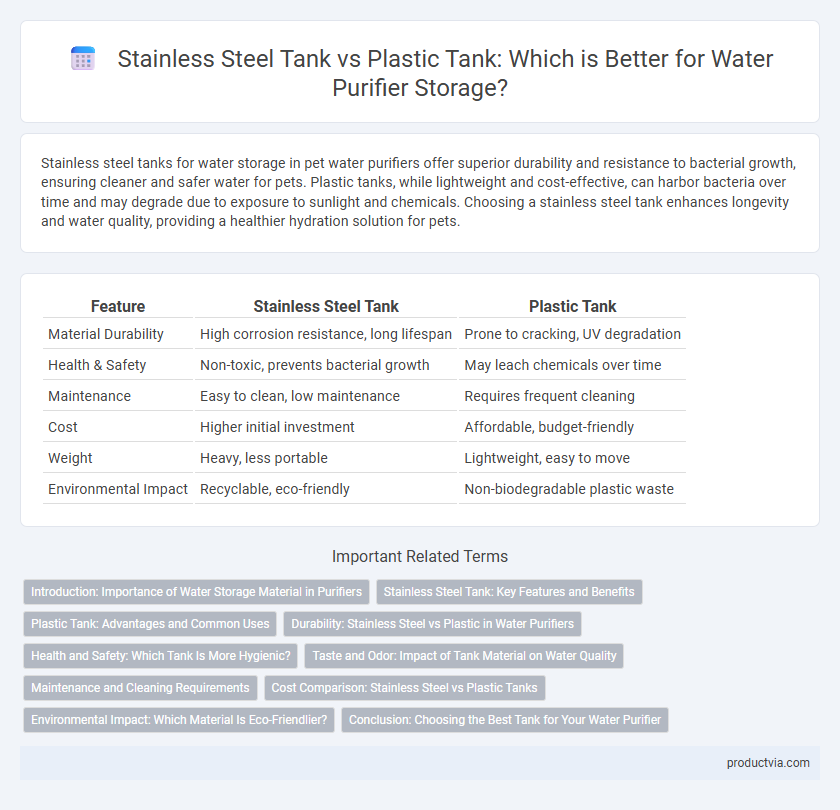Stainless steel tanks for water storage in pet water purifiers offer superior durability and resistance to bacterial growth, ensuring cleaner and safer water for pets. Plastic tanks, while lightweight and cost-effective, can harbor bacteria over time and may degrade due to exposure to sunlight and chemicals. Choosing a stainless steel tank enhances longevity and water quality, providing a healthier hydration solution for pets.
Table of Comparison
| Feature | Stainless Steel Tank | Plastic Tank |
|---|---|---|
| Material Durability | High corrosion resistance, long lifespan | Prone to cracking, UV degradation |
| Health & Safety | Non-toxic, prevents bacterial growth | May leach chemicals over time |
| Maintenance | Easy to clean, low maintenance | Requires frequent cleaning |
| Cost | Higher initial investment | Affordable, budget-friendly |
| Weight | Heavy, less portable | Lightweight, easy to move |
| Environmental Impact | Recyclable, eco-friendly | Non-biodegradable plastic waste |
Introduction: Importance of Water Storage Material in Purifiers
Choosing the right water storage material in purifiers is crucial for maintaining water purity and ensuring durability. Stainless steel tanks offer superior resistance to corrosion, bacterial growth, and temperature variations compared to plastic tanks. Plastic tanks, while lightweight and cost-effective, may leach chemicals over time and are prone to microbial contamination, impacting overall water quality and health safety.
Stainless Steel Tank: Key Features and Benefits
Stainless steel tanks for water storage offer superior durability and resistance to corrosion, ensuring long-term hygiene and safety. These tanks prevent bacterial growth and do not leach harmful chemicals, maintaining pure water quality. Their robust construction also supports effective thermal insulation, preserving water freshness and temperature stability.
Plastic Tank: Advantages and Common Uses
Plastic tanks for water storage in water purifiers offer lightweight, corrosion-resistant, and cost-effective solutions, making them ideal for households and small commercial setups. Their versatility allows easy installation and maintenance while ensuring safe water containment without metal contamination risks. Common uses include residential purification systems, portable water filter units, and low-pressure water storage applications.
Durability: Stainless Steel vs Plastic in Water Purifiers
Stainless steel tanks in water purifiers offer superior durability due to their resistance to rust, corrosion, and physical damage, ensuring long-term water quality and structural integrity. Plastic tanks, while lightweight and cost-effective, are more prone to cracking, bacterial growth, and degradation from prolonged exposure to sunlight or varying temperatures. Choosing stainless steel enhances purifier lifespan and maintains hygienic water storage compared to plastic alternatives.
Health and Safety: Which Tank Is More Hygienic?
Stainless steel tanks offer superior hygiene for water storage due to their non-porous surface, which resists bacterial growth and prevents contamination, unlike plastic tanks that can harbor bacteria in micro-cracks. They are corrosion-resistant, ensuring no harmful chemicals leach into the water, a concern often associated with lower-grade plastic tanks under prolonged use. Choosing stainless steel tanks enhances health safety by maintaining pure, uncontaminated water storage environments.
Taste and Odor: Impact of Tank Material on Water Quality
Stainless steel tanks preserve water's natural taste and prevent odor absorption due to their non-porous, inert surface that resists bacterial growth and chemical leaching. Plastic tanks, especially those made from low-quality polymers, often impart a plastic-like odor and alter the taste by releasing microplastics or chemicals over time. Choosing stainless steel for water storage ensures cleaner, fresher water with minimal risk of contamination affecting taste and odor.
Maintenance and Cleaning Requirements
Stainless steel tanks require minimal maintenance due to their corrosion resistance and smooth surface, which prevents bacterial buildup and simplifies cleaning. Plastic tanks may degrade over time, becoming prone to scratches and biofilm accumulation, necessitating more frequent and thorough cleaning to ensure water safety. Regular maintenance of stainless steel tanks is more straightforward and less labor-intensive, making them a preferable choice for long-term water storage in purifiers.
Cost Comparison: Stainless Steel vs Plastic Tanks
Stainless steel tanks typically cost more upfront than plastic tanks due to their durability and corrosion resistance, making them a premium choice for water storage. Plastic tanks are generally more affordable and lightweight, offering cost savings on installation and transportation. Long-term expenses favor stainless steel tanks as they require less maintenance and have a longer lifespan, reducing replacement frequency compared to plastic tanks.
Environmental Impact: Which Material Is Eco-Friendlier?
Stainless steel tanks excel in environmental sustainability due to their durability, recyclability, and resistance to corrosion, reducing the need for frequent replacements and minimizing waste. Plastic tanks, often made from polyethylene, pose environmental challenges as they contribute to microplastic pollution and have lower recycling rates, resulting in greater ecological footprints. Choosing stainless steel tanks supports long-term environmental health by promoting resource conservation and reducing plastic pollution in water storage applications.
Conclusion: Choosing the Best Tank for Your Water Purifier
Stainless steel tanks offer superior durability, corrosion resistance, and maintain water purity better than plastic tanks, making them ideal for long-term use in water purifiers. Plastic tanks, while lightweight and cost-effective, can leach chemicals over time and are prone to bacterial growth, which may compromise water quality. Selecting a stainless steel tank ensures safer, cleaner water storage and enhances the overall performance of your water purifier.
Stainless steel tank vs plastic tank for water storage Infographic

 productvia.com
productvia.com